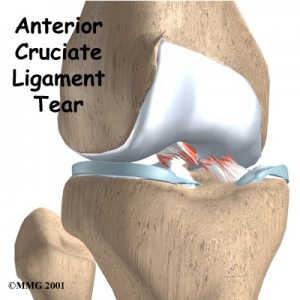What is Anterior Cruciate Ligament (ACL) Injury?
The anterior cruciate ligament, or ACL, is one of four major knee ligaments. The ACL is critical to knee stability, and people who injure their ACL often complain of symptoms of their knee giving-out from under them. Therefore, many patients who sustain an ACL tear opt to have surgical treatment of this injury.
What are the symptoms?
The diagnosis of an ACL tear is made by several methods. Patients who have an ACL tear often have sustained an injury to the knee. The injury is often sports-related. They may have felt a “pop” in their knee, and the knee usually gives-out from under them.
ACL tears cause knee swelling and pain. On examination, your doctor can look for signs of instability of the knee. These special tests place stress on the ACL, and can detect a torn ligament.
An MRI may also be used to determine if the ligament is torn, and also to look for signs of any associated injuries in the knee.
Is ACL surgery necessary?
ACL tears do not necessarily require surgery. There are several important factors to consider before undergoing ACL surgery. First, do you regularly perform activities that normally require a functional ACL? Second, do you experience knee instability? If you don’t do sports that require an ACL, and you don’t have an unstable knee, then you may not need ACL surgery.
There is also a debate about how to treat a partial ACL tear. If the ACL is not completely torn, then ACL reconstruction surgery may not be necessary.
Many patients with an ACL tear start to feel better within a few weeks of the injury. These individuals may feel as though their knee is normal again, but the problems with instability may persist.
Surgery of an ACL tear
The usual surgery for an ACL tear is called an ACL reconstruction. A repair of the ligament is rarely a possibility, and thus the ligament is reconstructed using another tendon or ligament to substitute for the torn ligament.
There are several options for how to perform ACL surgery. The most significant choice is the type of graft used to reconstruct the torn ACL. There are also variations in the procedure, such as the new ‘double-bundle’ ACL reconstruction.
Risks of ACL surgery include infection, persistent instability and pain, stiffness, and difficulty returning to your previous level of activity. The good news is that better than 90% of patients have no complications with ACL surgery.
Torn ACL – Allograft Graft






